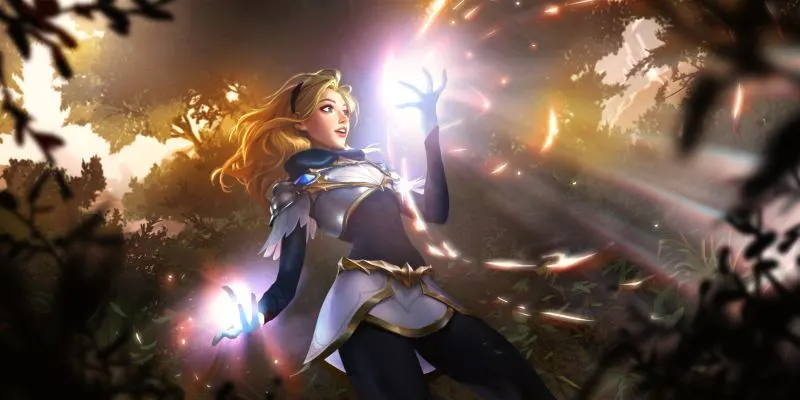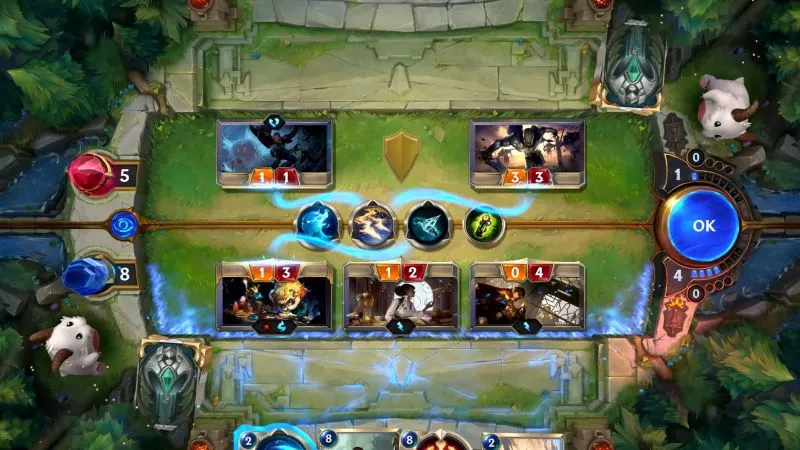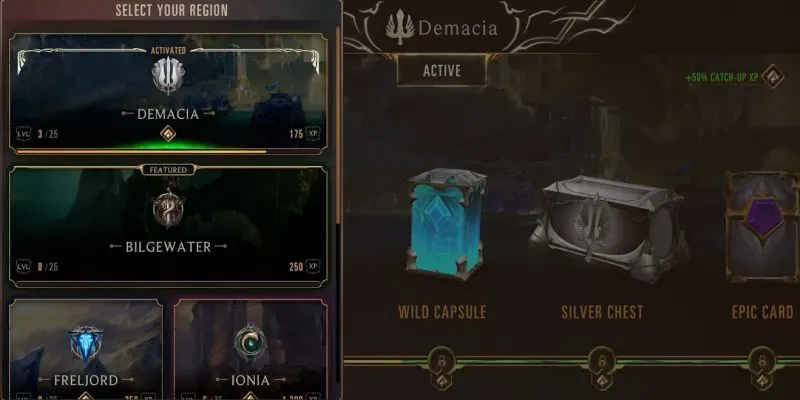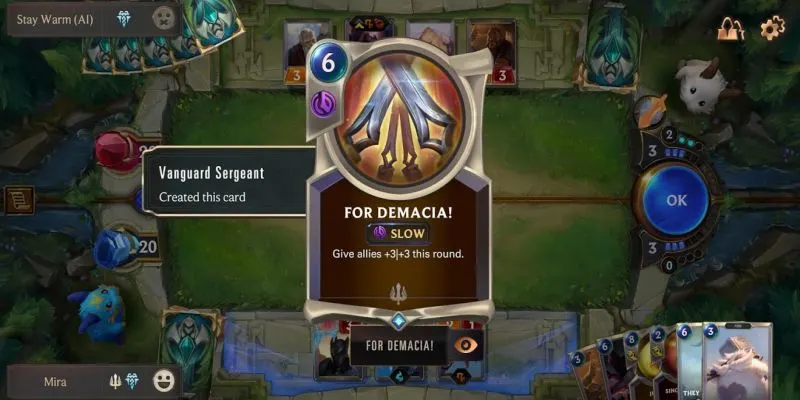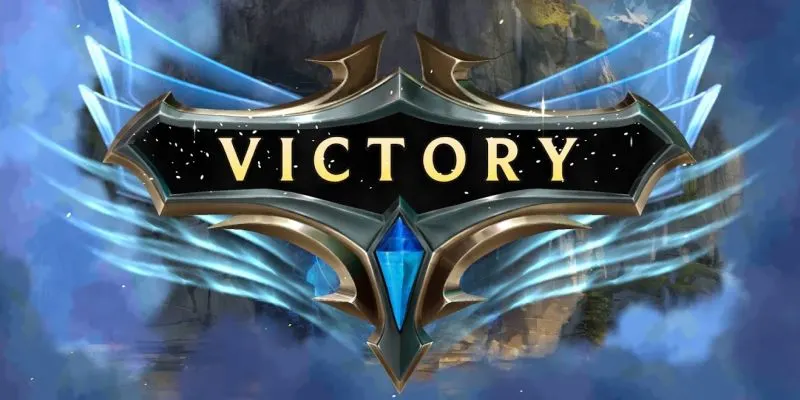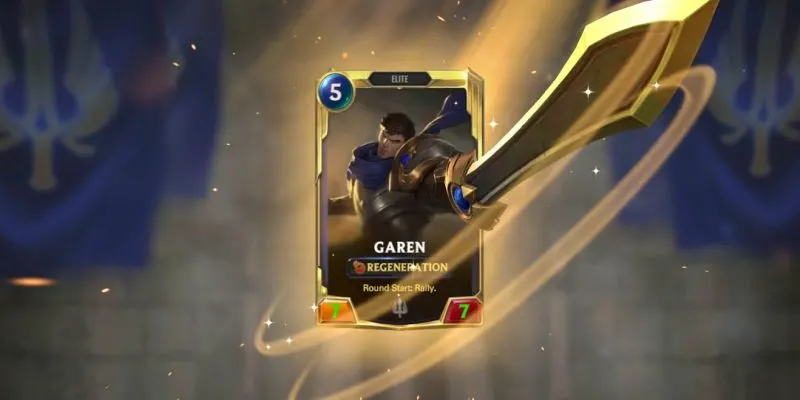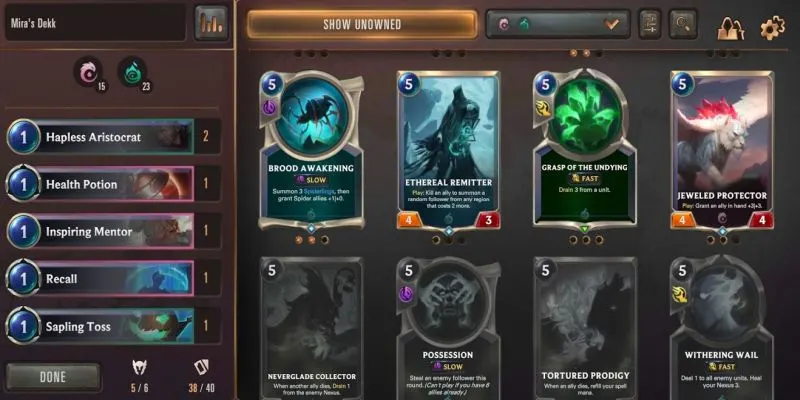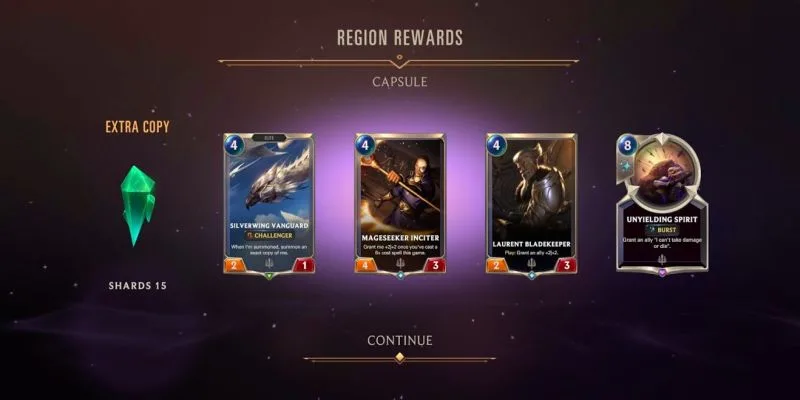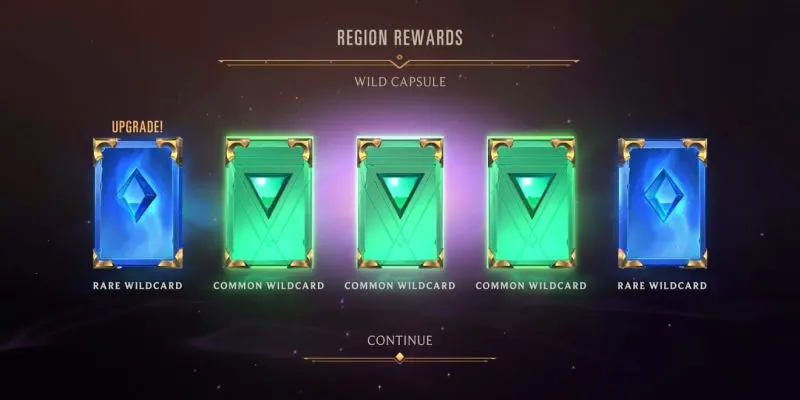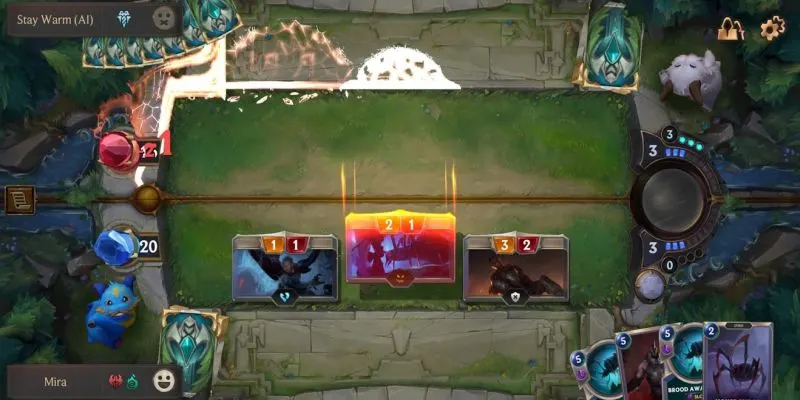Legends of Runeterra is Riot Games’ brand new strategy card game on mobile, which is based on the studio’s highly successful League of Legends. According to the developers, Legends of Runeterra is a strategy card game where skill, creativity, and cleverness determine your success.
Besides its super popular MOBA, League of Legends, Riot Games is also behind the fantastic auto battler Teamfight Tactics. The studio is currently working on a first-person shooter entitled Valorant which is expected to be released sometime in the summer of 2020.
While Legends of Runeterra arrives in a crowded space that’s already inhabited by established contenders like Hearthstone, Magic: The Gathering, The Elder Scrolls: Legends and the sort, it does come equipped with a major advantage which might attract players from outside the card game sphere – it’s inspired by League of Legends and borrows a lot of the characters and dynamics from the game. Just to give you an example, each of Legends of Runeterra’s champions (there’s 35 of them) are modelled after a character in the MOBA cleverly adapting their playstyle to fit the rules of the new card game.
For those who played digital collectible card games before, getting around Legends of Runeterra and understanding the mechanics is going to be a piece of cake. Noobs, however, will uncover a complex universe governed by an extensive set of laws that they will need to grasp before having any hope at mastering the game.
The basic rules of most card games apply to Legends of Runeterra. Two players are pitted against each other and have to fight it out until one succumbs to the other’s might. At the beginning of the game, each player has a Nexus (heath) of 20, and the goal is quite intuitive – drain your opponent’s health points until they reach 0. When this happens, you will be declared the winner of that particular game and will receive XP as a prize.
Now, like in most cards games, players will have to make use of mana to summon units – which are divided into followers and champions, the former being the core components, as your party will basically be built around them. Champions appear more sporadically and unlike followers, they can be leveled up. The criteria for levelling up is listed on the cards and differ from champion to champion.
When upgrading finally happens, all copies of the champion in your deck are also upgraded. Note that the game lets you to summon one champion at the time. This means you can’t bring another Jinx, for example, in the game, if you have already deployed her to your ranks.
As for followers, they can be present as duplicates on the field at any point. While followers don’t wield the same power as champions, they are still very important to the game, especially in the first stages, when mana is low and it is vital that you are able to defend your flanks. Additionally, they can have unique synergies with champions and other cards that might turn things in your favor during battle.
In Legends of Runeterra, there are two types of cards: ally and spell cards and both depend on the mana that gets replenished each round. There are four types of spells available, but we’re going to detail them in section 2. Unlike in other card games, in Legends of Runeterra the mana that isn’t used during a turn is recycled in up to three crystals and becomes spell mana during the following turn. As you can see, regardless of the similarities with other games, Legends of Runeterra does distinguishes itself from the pack by flaunting its own notable differences and quirks.
These are the preliminary aspects that you need to know before getting started with the game. But if you feel like you need some help, read on as we have compiled a detailed Legends of Runeterra beginner’s guide. This strategy guide comes with loads of tips, cheats and strategies that are meant to help you make your way across the game as fast and smooth as possible so that you can destroy your opponents with ease.
1. First Thing’s First – Study The Regions
Legends of Runeterra allows you to unlock a wide variety of cards that lets players to adopt a range of unique playstyles. Whatever your preferences, you need to know that cards can be grouped by regions and getting to know these regions and their specifics is a highly important task you need embark upon before you can throw yourself in battle.
As you should strategize and prepare yourself before heading to the battlefield, we advise you not to rush immediately into battle. Instead you should get to know the cards and in doing so you will win more frequently and thus gain more and better cards which will allow you more options and combinations.
All regions in the game possess unique strengths and weaknesses that need to be leveraged very carefully in order to yield the best result, so there is a lot to learn.
Bilgewater – Champions include Fizz, Gang Plank, Miss Fortune, Twisted Fate and Nautilus.
Demacia – Champions include Garen, Lux, Fiora, Lucian and Quinnn.
Freljord – Champions include Sejuani, Ashe, Braum, Tryndamere and Anivia.
Ionia – Champions include Yasuo, Shen, Lee Sin, Karma and Zed.
Noxus – Champions include Swain, Valdimir, Draven, Darius and Katarina.
Piltover & Zaun – Champions include Jinx, Teemo, Heimerdinger, VI and Ezreal.
Shadow Isles – Champions include Elise, Hecarim, Kalista, Maokai and Thresh.
Knowing your regions and their characteristics is a key component of becoming a skilled player that can conquer all enemies, but it’s by no means the only reason why should immerse yourself into a deep study of the regions. Understanding the cards and their unique mechanics lays the foundation for creating advanced decks in Legends of Runeterra (more on that in section 4).
Speaking of decks, in the beginning, the game offers you three already formed decks which blend elements from a few different factions:
Buff and Tuff – combines cards from Demacia and Freljord
Death and Spiders – combines cards from Noxus and Shadow Isles
Spells and Stealth – combines cards from Ionia and Piltover & Zaun
It’s a good idea to give these preliminary decks a go, so you can see how they suit you. If you don’t find them worthy of your standards, you can always commit to building a custom deck later (more on that on section 4). Additionally, players can unlock a new deck every 7 days.
In the beginning, it’s recommended to embark on Challenges as much as possible. On top of bringing in additional XP, Challenges allow you to try out all kinds of decks, while breaking down every type of situation and interaction that might arise during a match via guided play.
2. Use Spells Diligently And Relentlessly
Spells are super important in any card game, and the same stands true for Legends of Runeterra. While having strong legions will help with destroying the enemy’s Nexus, you won’t be able to unleash their true force if they get obliterated by the foe’s spells. An understanding of how spells work is therefore crucial if are to use them with success, either when attacking or countering enemy attacks.
The first thing you need to know here is that every spell in Legends of Runeterra features a speed property that determines when a spell can be played during a match and if your enemy can respond before you cast it. They can be classified as follows:
Burst: the fastest kind of spells. They can be used at any time and can’t be countered by the opponent. After a Burst spell is cast, the turn does not end, so players can have a go at another action.
Fast: spells that can be activated at any time, but enemies have the opportunity to cast a counter burst/fast spell of their own. However, you can queue up multiple at a time, before the opponent can respond.
Slow: these spells can be cast only outside of combat and the enemy is allowed to respond to them.
Fleeing: these spells are temporary so they need to be used by the end of the turn, or they will disappear.
Given the different types of speed of spell cards, the right timing for casting a spell has to be carefully determined and weighed. Additionally, players need to choose wisely what spells to add to their decks. It’s helpful, that the game recycles mana points you haven’t used during a turn, therefore giving you the option to cast additional spells with the leftover mana.
Modeling the mechanics in League of Legends, spells can be used offensively as well as defensively, allowing players to inflict great amounts of damage, provide protection or even deal a killing blow. For example, Prismatic Barrier from Demacia allows to give an ally Barrier (negates the next damage the unit would take and lasts one round) during a round, while Ritual of Renewal from Ionia heals an ally or your Nexus 7 than draw 1.
Something else you want to keep an eye on are the keywords which appear on both allies and spell cards. Those keywords are the different abilities a card can bestow on top of other more special or unique abilities. There’s a lot of different kind of keywords and certain combination of those can be very effective strategies. Having a great variety of different keyword abilities is great for different situations but sometimes strategies are based on a combination of 2 or 3 different keyword abilities.
An example of this is the combination of cards that are elusive and other spells or allies who can provide barriers. Being elusive means an opponent cannot block you and a barrier provides a protection against damage during battle. So if you have a stronger card that is elusive like The Empyrean in combination with a card that can give barriers like Spirit’s Refuge then you have a very strong combo that can deal a lot of damage while also providing the necessary defense. You can also add some buff spells for even more damage.
Vulnerable and overwhelm are also a good mix of keyword abilities. Making an enemy vulnerable allows you to challenge an enemy card and force it into battle. Combine this with an overwhelm ability and all the excess damage dealt to the blocker will be dealt to the enemy’s life point. So if you have the champion card Darius and play a spell like Caught in the Cold on a weak enemy card then you will deal quite a bit of damage. Add a little buff spell to boost your cards stats and you’ll have a very effective attack for sure.
Another trick we want to point out, especially if you find yourself in a scenario where you are up against a spell-heavy deck, is to use the Oracle’s Eye on the left to view how each spell will impact the board and adapt your strategy accordingly. The blue orb is located between the two Nexuses, and while it stays closed most of the times, it opens when it can predict how your choices will play out in the game. So, if you have a sequence of slow and fast spells that you want to put in practice, you can use the Orb to determine whether they will unravel in your favor or not.
3. Exploit The Champion Cards As Much As Possible
Champions are one of the most valuable elements in Legends of Runeterra. Not only are they very strong cards on their own, but using them in the right way and combining them with the right spells or allies is crucial to a favorable outcome. What makes these cards special is also the fact that you can level them up by reaching certain goals. This enables champions with lower stats to become stronger but also boosts their unique skills thus making already useful abilities even better.
Different champions have different abilities and combined with different allies, spells or other champions may be devastating. To give you an example, Braum has the special ability to decide who is going to block him and then to regenerate his health. This in concert with some buff spells makes him incredibly effective for defense while also taking into account offense.
Additionally, once he takes up to 10 damage points he will level up and become even stronger, on top of being able to summon a Poro that you can use to attack. Cards like Braum that concentrate on a good defense are ideal if you want to build up strength for some devastating attacks while also defending against your opponent’s assault on your life points.
On the other hand, it can be useful if you learn to combine the appropriate spells with the right champions. A perfect example of this is the champion Tryndamere who in combination with board wipe cards can do some devastating damages. This is because Tyrndamere has the unique ability to be revived and get back even stronger when he is destroyed. So damaging his life point is not an issue, it’s actually to be encouraged.
4. Try Your Hand At Building A Custom Deck
A deck consists of up to 40 cards and the maximum number of duplicates of the same card in a deck is limited to 3. You can use up to 6 champions in a single deck. When building a custom deck, we advise to try and get these 6 champions in your deck so you can draw them as frequently as possible. In order to have cards from a certain region in your deck you first need to have a champion of that region. So if you want to use multiple regions you need at least one champion of each region in your deck.
You can have a deck of only one region but combining 2 regions is encouraged and advised. That’s because each one has its own specialties and some of them work very well together. For example, a region that specializes in good defense makes good house with a region that’s all about building up strength so you can win with some fierce attacks.
As we already recommended above, reading up about the strengths and weaknesses of each region is important so you can decide which are the best to combine. Do note, however, that you can only have a maximum of 2 regions in one deck so choose wisely.
We talked about champions playing a pivotal role in your strategy but you shouldn’t neglect follower units either. Choosing the right followers for your deck is just as important as choosing the right champions. Some of the followers have really impressive base stats and even practical abilities that can be extremely useful.
In fact, in the beginning followers are the only cards you can summon in the game (due to low mana) but with some creativity they can be employed in other ways. An example of this are weak units in combination with the Phantom Prankster follower card (Shadow Isles region). Her ability is that when another ally dies 1 damage point is dealt to the enemy Nexus. In a later part of a game this may not be useful but in the early stages it’s a good way to defend yourself while still being able to do some damage.
Another example of a useful follower with an interesting ability that is a great addition to any deck is Jewelled Protector (Ionia region). His special power allows him to bestow a very strong buff (+3/+3) to a card in your hand. This card works great in combination with powerful cards such as the Empyrean follower card (Iona region) which has already 6 attack points on top of being elusive which means this particular synergy could inflict a crushing blow to your enemy.
While ally cards are very important when building a deck, don’t disregard spell cards. Crafting a deck that can utilize both reactionary and offensive spells would be advised when you’re looking to protect your most precious cards from enemy attacks, while also looking to do as much damage as possible to the foe.
Of course the most important thing when it comes to deck-building are the actual cards, so we advise you to participate in Expeditions and grab your game rewards as much as you can to win a maximum of new cards (more on that in section 5). Once you decide which regions you want to base your deck on, make sure you Activate them in turns in the Rewards tab, so all the XP you gain after battle will go towards unlocking chests with cards from that particular region.
You can also invest real money to get the resources for buying Wildcards that can be used to unlock cards. This is not essential for a good deck but spares you some time to get there.
5. Always Work Towards Getting New And Better Cards
In order to build yourself a killer custom deck that will help you obliterate any foe, you need to hoard as many cards as possible. Acquiring cards in Legends of Runeterra is possible via several avenues and in this section we’ll detail a few that we think you should try.
As mentioned above, there are micro transactions in the game, but they are an option not a necessity. Luckily you get enough rewards and gifts in the game to make a good progression, and therefore we recommend you to play the game every day to unlock daily chests that are usually rich in Wildcards and new cards. Legends of Runeterra also serves up a weekly vault which unlocks every Tuesday and is packed with all kinds of goodies.
Another way to get more cards is through Expedition. In order to participate you have to pay game money, shards or tokens. In expeditions you don’t get to use your deck but instead players get to pick cards from 3 different sets of cards until they reach 30 in total. Winning games enables players to make better decks by trading cards or adding more champions to them. You get different rewards depending on your number of wins, and even if you have 0 wins, you still get additional XP.
As you start winning matches, XP accumulates and eventually that unlocks chests and capsules proprietary to a certain region filled with cards, Shards and Wildcards. Keep in mind that you can unlock chests and other goodies for one region at a time. You will need to activate each from the Rewards tab in the main menu.
Still need more cards? The game even lets you craft missing cards using Wildcards or Shards. Wildcards are tokens that players can exchange for the card depending on the rarity of the card. You can get them as rewards when opening up boxes or by spending real money.
As for Shards, they can be used to pay for the different types of cards. A Common card costs 100 Shards, a Rare 300, an Epic 2500 and a Champion will cost you up to 3000 Shards.
6. Abstain From Blocking Or Attacking Whenever Its Convenient
Complex strategies are at the core of Legends of Runeterra, so while it might seem intuitive to attack and block whenever you have the chance, sometimes doing so does not produce the best outcome.
Even if sometimes it is worth absorbing that direct damage from the enemy, other times it is far wiser to abstain and focus on preserving your allies and strengthening their power. In the beginning you when you’re busy building your team of allies, loosing even one or two of them will make you vulnerable in the face of the enemy.
This is why early on it would be a good idea to commit to attacking your foe when it has nothing to defend itself with. Similarly, blocking should be performed only when the enemy places a card that you know you can easily overwhelm.
As a new round starts, you will be granted a new card and more mana. This means you will have the chance to summon stronger characters and get your hands on useful spells that can better complement your units and turn the odds in your favor.
This concludes our Legends of Runeterra beginner’s guide. We very much hope you have learned some useful tricks that you can apply to your gameplay so that you become more effective against your enemies. If you have played Legends of Runeterra enough and have come across some tips you haven’t spotted in this guide, we encourage you to share them with us and our readers in the comment section below!

